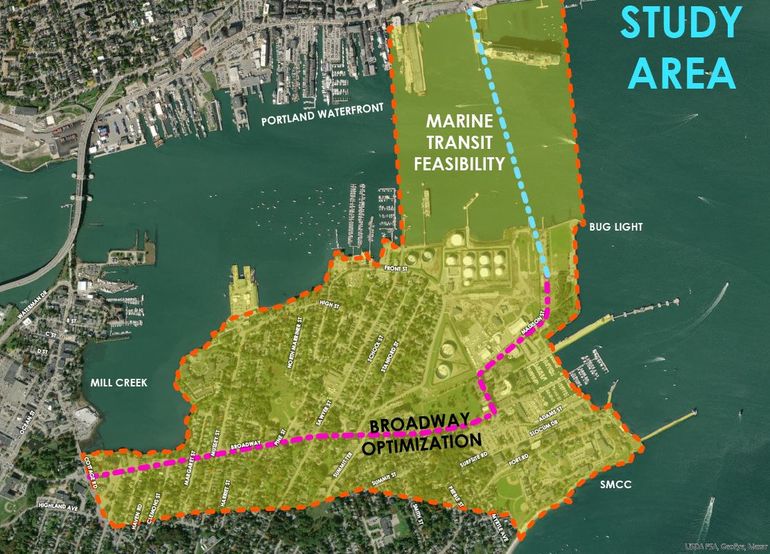Transit recommendations for South Portland's Broadway corridor ready for public input
 Courtesy / Greater Portland Council of Governments
Transportation improvements for an area of South Portland are deemed important to spur development.
Courtesy / Greater Portland Council of Governments
Transportation improvements for an area of South Portland are deemed important to spur development.
Recommendations for transportation improvements along South Portland’s Broadway corridor and nearby neighborhoods are headed for an online public meeting on June 28.
The meeting will be held by the city of South Portland and Greater Portland Council of Governments. The recommendations are based on findings from the Cushing’s Point Transportation Study.
The draft recommendations include improvements in transit, bike, and pedestrian facilities, traffic management, and an initial look at the feasibility of a marine ferry to and from Portland, according to a news release.
Bus service
For transit improvements, the plan's primary goal is to improve bus service on the Broadway corridor by decreasing travel times, increasing service frequency, and providing safe and accessible bus stops with connections to other modes of transportation. Opportunities for improving efficiency by shifting routing schedules are proposed for Route 21 and Route 24A. The study also identifies technology improvements on Routes 24A and 24B to shorten bus travel times and make bus travel more reliable.
Microtransit is currently used for trips to and from the Food Cupboard and could be expanded to the Cushing’s Point area of South Portland. Microtransit is a kind of transit that is more flexible in terms of routes and timing than fixed-route bus service.
Reduce solo drives
To support traffic management, recommendations include the creation of land use and development policies that encourage transit use and reduce drive-alone trips. The study also recommends adopting the use “adaptive traffic signal” technology, which could reduce travel time in the corridor by 11% or more. Adaptive signals adjusts the timing of red, yellow and green lights to accommodate changing traffic patterns.
Increasing bicycle and pedestrian trips is also a goal. To make biking and walking more attractive, planners recommend widening and enhancing the Greenbelt as the primary facility for accommodating bike traffic, adding bike lanes where land acquisition would not be needed, and slowing vehicle traffic on selected neighborhood streets to make cycling safer.
Adding sidewalks and improving and expanding pedestrian crossings are recommended for multiple neighborhood streets. New sidewalks would be added where there are gaps in the system and where traffic volumes and usage indicate the need for a more distinct separation between pedestrians and vehicles.
Ferry service
Using existing projections for residential growth, a ferry service analysis concluded that a 40-person vessel running directly across the Fore River between South Portland and Portland is feasible in the future. However, the service would most likely be an amenity and would not play a key role in reducing vehicle usage in this area of South Portland and in the region.
Ripe for development
The effort to address transportation challenges began last fall with the Cushing’s Point Transportation Study.
Cushing’s Point in South Portland has long been ripe for new housing and commercial development. But efforts to build out the area have been stymied by lack of traffic access — the only way to get to the end of the peninsula is Broadway. The two-lane route runs through a tight, mostly residential neighborhood before it dead-ends at a tangle of narrow streets, Bug Light Park, marinas and Southern Maine Community College.
But as housing demand increases, South Portland expects the area to see increased growth. The city's comprehensive plan envisions moderate-density housing and walkable neighborhood centers.
The transportation study is expected to conclude this fall. The online public meeting is scheduled for June 28 from 6-7:30 p.m. For more information, click here.
Mainebiz web partners
Why wouldn't the ferry service connect to the neighborhood? Being able to walk to the ferry would likely attract more riders than have to take the bus to the ferry.










1 Comments